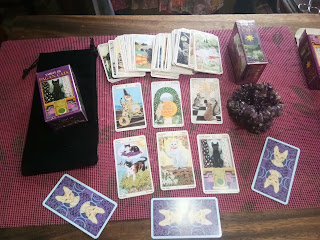Tarot cards are usually quite big - 4.75 inches x 2.75 inches or 12 cm x 7 cm. This is too big to be put in one's pocket. For males who would not want to carry clutch bags or attache cases, having a set of Tarot cards that can be put in one's pocket would be ideal.
Luckily, there are Mini or Pocket versions that are usually 3 to 3.5 inches by 1.75 to 2.25 inches or 7.6 to 8.9 cm by 4.4 to 5.6 cm. The Tarot of the Pagan Cats has a very cute version that is no more than 3 inch or 8 cm in length and 1,75 inch or 4.6 cm in width.
Cat lovers would find these cards to their taste as it features lovely cats instead of humans. The images are pleasant to look at and not too brightly colored.





Comments